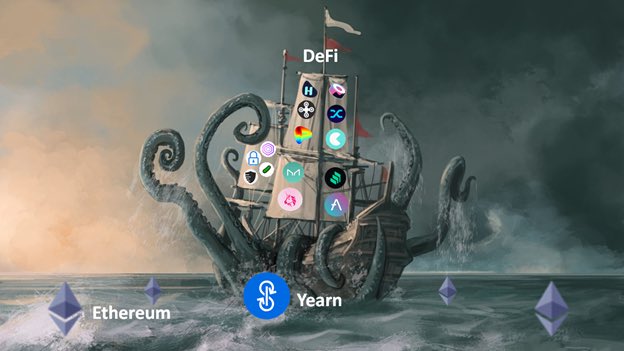
There’s been a ton of development in the Yearn ecosystem recently to the point where it’s worth asking again:
What the hell is Yearn?
@jotto and I did a deep dive into the theory of Yearn to breakdown what Yearn is and where it’s going.
1/
What the hell is Yearn?
@jotto and I did a deep dive into the theory of Yearn to breakdown what Yearn is and where it’s going.
1/

It all starts with the theory of the protocol.
Protocols are coordination mechanisms that define rules and provide incentives for market participants to facilitate economic activity at a global scale.
messari.io/article/the-th…
Protocols are coordination mechanisms that define rules and provide incentives for market participants to facilitate economic activity at a global scale.
messari.io/article/the-th…
The second building block to understand Yearn is to understand a key premise of DeFi:
DeFi provides individuals unprecedented access to financial opportunities traditionally reserved for HNW individuals and regulated financial institutions.
DeFi provides individuals unprecedented access to financial opportunities traditionally reserved for HNW individuals and regulated financial institutions.
But the challenge with this freedom is that finance can oftentimes be very complex and with so many opportunities it may be hard for people to decide what to do.
So Yearn fundamentally asks, “what would a crypto-native 21st century wealth management solution look like?”
So Yearn fundamentally asks, “what would a crypto-native 21st century wealth management solution look like?”

It would not look like a plain vanilla savings bank where people deposit their money to a firm, which then uses that money to generate a return - the bank's shareholders reaping the lump sum of the value created.
Nor would it look like a modern wealth management app that is also extractive, beholden to local regulators and limited in its functionality.
Instead it would be a globally accessible, fully transparent, minimally extractive, and credibly neutral protocol that would provide the majority of value created back to users.
nakamoto.com/credible-neutr…
nakamoto.com/credible-neutr…
This protocol would just be a coordinator between capital allocators and capital providers.
And it would provide easy access to and automated management for every financial opportunity available on Ethereum (or any blockchain for that matter).
This is what Yearn is at its core.
And it would provide easy access to and automated management for every financial opportunity available on Ethereum (or any blockchain for that matter).
This is what Yearn is at its core.
Yearn is a protocol for capital allocation.
It coordinates capital allocation through incentivizing capital providers with the highest possible yields, while incentivizing capital allocators (i.e. “strategists”) with the highest possible AUM to allocate.
It coordinates capital allocation through incentivizing capital providers with the highest possible yields, while incentivizing capital allocators (i.e. “strategists”) with the highest possible AUM to allocate.
But where exactly is Yearn going?
Yearn’s recent “mergers” with Pickle, Cream, SushiSwap, Akropolis, and Cover help illuminate Yearn’s masterplan.
Yearn’s recent “mergers” with Pickle, Cream, SushiSwap, Akropolis, and Cover help illuminate Yearn’s masterplan.

Yearn’s recent mergers aren’t mergers in the traditional sense of acquiring assets and governance rights.
There will still be separate tokens, treasuries, and governance systems for these “merged” protocols.
There will still be separate tokens, treasuries, and governance systems for these “merged” protocols.
Instead Yearn is merging developer talent across these protocols to more tightly coordinate roadmaps - an important part of scaling Yearn.
For example, Yearn’s plan to launch Deriswap on SushiSwap, has the potential to allow liquidity supplied to SushiSwap to be simultaneously used to facilitate trading, lending, options, and futures, increasing the yield per dollar of liquidity provided.
Increased capital efficiency is good for Yearn because it boosts the returns for its capital providers (vault depositors).
Yearn’s other mergers are aimed at achieving similar goals of scaling Yearn, whether it be insuring vaults (Cover), attracting institutional liquidity (Akropolis), acquiring strategists (Pickle), or building out an in-house money market (Cream).
What does this all mean?
In short while Yearn, the protocol, is a coordination mechanism for efficient capital allocation, Yearn, the ecosystem, aims to be a conglomerate of symbiotic financial protocols that increase the capital efficiency of DeFi as a whole.
In short while Yearn, the protocol, is a coordination mechanism for efficient capital allocation, Yearn, the ecosystem, aims to be a conglomerate of symbiotic financial protocols that increase the capital efficiency of DeFi as a whole.
The greater the capital efficiency in DeFi, the greater the opportunity for Yearn to scale its operations.
The name of the game for Yearn is to attract enough capital and enough capital allocators (strategists) to build a network effect.
The name of the game for Yearn is to attract enough capital and enough capital allocators (strategists) to build a network effect.
At this point, Yearn would become the “shelling protocol” for capital allocation - everyone will coordinate around Yearn, and the incentives to defect to another protocol would be weak.
Yearn’s recent “mergers” are aimed at creating an ecosystem around Yearn to ensure Yearn becomes the schelling point for capital providers and capital allocators to coordinate around.
The cryptoeconomy is a new economy with new competitive dynamics.
Dive deeper into the theory of the Yearn to understand what the hell is going on 👇🏾
messari.io/article/the-th…
Dive deeper into the theory of the Yearn to understand what the hell is going on 👇🏾
messari.io/article/the-th…
• • •
Missing some Tweet in this thread? You can try to
force a refresh






